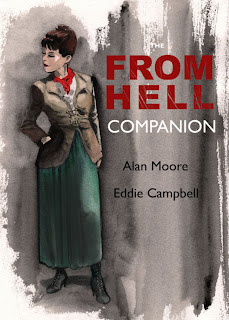Queen Victoria's physician Sir William Gull is revealed as Jack the Ripper as early as the second chapter of From Hell. Gull experiences increasing visions during his ritualistic murders, glimpsing future shock moments such as television and mobile phones.
THE sprawling, post-modern From Hell remains a work Alan Moore is proud of. The book's fourth chapter holds a special significance for the writer, as a line of dialogue - "the one place in which Gods and demons inarguably exist is in the human mind where they are real in all their grandeur and monstrosity" - sparked his interest in becoming a magician, fueled by drugs and imaginative concentration. Moore has never been a fan of tags, stating in a Mustard #4 Vol II (March 2009) interview "my experience of life is that it is not divided up into genre; it's a horrifying, romantic, tragic, comical, science fiction cowboy detective novel ... with a bit of pornography if you're lucky." Subsequently, From Hell is more than a graphic novel of the Whitechapel murders, rather a meditation on the mechanics of five socially-charged murders that expertly adhere to Moore's quest that his work acts "like a drug ... if you put the words in the right order with the pictures, you can create a psychedelic state."
This Knockabout softcover is a selection of Moore’s original scripts and sketches for his alluringly brutal masterpiece, with annotations and commentary from the books' artist Eddie Campbell. Campbell provides a fascinating series of narrative-order anecdotes and confessions that only he can, having shared an exhausting decade-long journey that survived three publishing bankruptcies and spawned a vacuous film adaptation. Moore’s voluminous, capital-bashing scripts are overpowering in detail - for example, in a chapter three market scene, a single 3" x 2" panel could never start to depict an envisioned sexual relationship between two street urchins - and Campbell includes a word count for each of the entries like a badge of honour, the highest of which surpasses 2000. It is therefore refreshing that even though the reader is awash in the dankness of Victorian London, Campbell - despite an over reliance on references from Wikipedia - speaks comfortably and clearly about the problems with confronting such an onslaught and its transition to the comic page.
"Our story's written, Netley, inked in blood long dry ... engraved in stone." A new Eddie Campbell watercolour graces the cover of The From Hell Companion; in Campbell's epilogue, one closes the book sharing the illustrator's sentiment "all the people that I worried I could never quite bring to life now sadden me with their last glimpse."
What is evident when reading through this companion is that when the artist did diverge from the writers intentions, Campbell chose a similar clarity. Yet one wonders if the passionate descriptions are best suited to the comic book page; the completed From Hell could only ever have been a dilution of Moore's meticulous actions, foundations creating mood and tone that would possibly only stand justice in a series of hefty novels. The FROM HELL movie is just that, diluting the book's convoluted narrative in a way only a Hollywood blockbuster can. Moore has never championed the silver screen, insisting that the medium is inherently technical thus financial, creating a tendency to drive and immerse the viewer on a set path thus limiting personal interaction and development. Books and comics therefore are the arts of choice for the Northampton magus, where the reader isn't spoon-fed.
In the foreword, Craig Fischer and Charles Hatfield highlight the need for a companion book, to explain a project that is densely threefold: firstly, the connections between freemasonry, occultism and architecture; secondly, how these heady subjects are insight-fully woven into a story; and thirdly, how a personal friendship and artistic collaboration survives under such prolonged duress. Moore has always been more vocal and robust in his theories than his esteemed artist, but Campbell is equally fascinating as both an individual and illustrator; the Australia-located Scot surmises that the human condition cannot except a random universe, inventing its Gods and conspiracies to explain at least some order. Perhaps it is better to believe that evil is in control, rather than there being no control.


